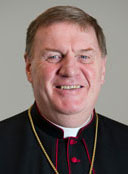Rejoice in the Lord
Dying with dignity on our journey ‘to the house of the Father’
 On March 31, 2005, the Vatican confirmed that Pope John Paul II was near death. Tens of thousands gathered in St. Peter’s Square to pray with and for the dying pope—now St. John Paul II. On Saturday, April 2, at about 3:30 in the afternoon, the Holy Father spoke his final words, “Let me go to the house of the Father.” A few hours later, he died.
On March 31, 2005, the Vatican confirmed that Pope John Paul II was near death. Tens of thousands gathered in St. Peter’s Square to pray with and for the dying pope—now St. John Paul II. On Saturday, April 2, at about 3:30 in the afternoon, the Holy Father spoke his final words, “Let me go to the house of the Father.” A few hours later, he died.
The pope’s suffering and death were as open and public as one person’s life could be. In fact, during the course of his 27 years of papal ministry, the whole world witnessed his progression from an extremely active 58-year-old man in excellent health, who was unquestionably the most athletic and “fit” pope in modern history, to an infirm and feeble old man who could not walk, who shook uncontrollably from the effects of Parkinson’s disease, and who was barely able to speak.
St. John Paul showed us by his personal example what it means to surrender the gifts of youth and vibrant health. Over time, he became totally dependent on others for his every human need. He could not feed himself, bathe himself or dress himself. He who had been so active, so independent and so strong became—before the eyes of the world—weak and immobile and helpless.
Contrast this story of one man’s acceptance of suffering and death with news reports last October of a woman who moved her family to Oregon so that she could end her life voluntarily and, so, avoid the pain and suffering of a terminal illness. “There isn’t a single person who loves me that wishes me more pain and more suffering,” the young woman was quoted as saying. With the assistance of a physician, she ended her life before the disease could end it for her.
Our hearts are filled with sadness when we read stories like this. It is surely true that no one who loves us wishes us to experience pain and suffering. But as Pope Francis recently noted, we need to be careful not to give in to “a false sense of compassion.”
Although Pope Francis would never be harsh or judgmental toward someone who is tempted to take his or her own life, he forcefully reminds us that we can never take a human life—even, or especially, our own. “Beware,” the Holy Father admonishes, “because this is a sin against the creator, against God the creator.”
People of faith believe that suffering can be redemptive. We only have to consider the cross of Christ to be reminded that God himself chose not to avoid painful suffering and humiliation, but to accept it—for our sake.
Christians believe that suffering can be an occasion of grace—for those who suffer and for those who are called to care for them.
In our archdiocese, the Little Sisters of the Poor provide powerful witness to this conviction. Their care for the aged and infirm quietly proclaims their belief that “dying with dignity” comes not through the avoidance of suffering, but with its humble acceptance.
St. John Paul II wanted us to see that the painful, often humiliating process of turning over our lives to God can be redemptive when conformed to the cross of Christ. He wanted us to experience the truth that people who are old, sick and severely handicapped matter more than ever. They are not “useless” or disposable. On the contrary, he wanted us to see that we can support them and learn from them as they take their final steps in the journey to “the house of the Father.”
Some would say that, toward the end, the pope’s life had lost its meaning and should have been terminated mercifully. John Paul would have none of that. He taught, by his example, that whatever its motives and means, direct euthanasia is always morally unacceptable.
St. John Paul II knew that end-of-life decisions are often painful and complicated. Life should not be prolonged by means that are “dangerous, extraordinary or disproportionate to the expected outcome” (Catechism of the Catholic Church, #2278). With the Church’s blessing, he refused to accept “overzealous” treatment. He chose to die with dignity—not by taking matters into his own hands, but by allowing God alone to specify the day and the hour.
Our Church has many reasons to be grateful to St. John Paul II, including for the way he suffered and died. He didn’t make it look easy or painless. He didn’t hide his frustration or his helplessness.
Instead, he showed us one man’s way of taking up his cross and following Christ. May his witness inspire us all. †
 On March 31, 2005, the Vatican confirmed that Pope John Paul II was near death. Tens of thousands gathered in St. Peter’s Square to pray with and for the dying pope—now St. John Paul II. On Saturday, April 2, at about 3:30 in the afternoon, the Holy Father spoke his final words, “Let me go to the house of the Father.” A few hours later, he died.
On March 31, 2005, the Vatican confirmed that Pope John Paul II was near death. Tens of thousands gathered in St. Peter’s Square to pray with and for the dying pope—now St. John Paul II. On Saturday, April 2, at about 3:30 in the afternoon, the Holy Father spoke his final words, “Let me go to the house of the Father.” A few hours later, he died.